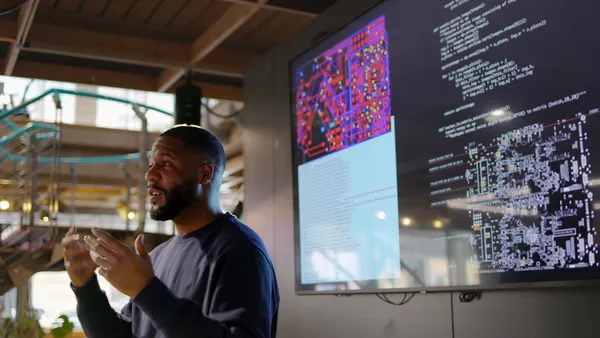It's no secret that remediation is a major concern in education today. According to research out of Columbia University's Teachers College, an estimated 60% of community college students require it, and around $4 billion in state and federal funds are spent on it each year. The need for remedial learning is likely to gain even more of the spotlight as President Barack Obama's plan to provide free community college to qualifying students moves forward, as successfully addressing the issue could prove critical to the plan's success.
It's a topic Pearson North America President Don Kilburn feels particularly strong about. According to Kilburn, there are three core areas where modest improvement can reduce the cost of remediation and improve outcomes significantly: assessing outcomes at every stage, including products and services; using ed tech as the catalyst for improvement; and providing professional development on new tools and methods.
We caught up with Kilburn—who sees the world's largest education publisher's mission as one of social responsibility—at last week's SXSWedu in Austin, TX, to discuss remediation, as well as the PowerSchool sale and Pearson's response to a recent Politico article questioning its business practices.
EDUCATION DIVE: Just to start out, tell me a little bit about what you’ve seen in Pearson’s research into lowering remediation costs, and what works and doesn’t work?
DON KILBURN: To me, it’s a really critical issue because you have kids graduating from high school who aren’t really college-ready at that point. And if they’re not college-ready, they’re probably not career-ready at the same time. I think that’s an issue that kind of gets lost in the discussion: For those who don’t want to go right to college, are they ready for a career? A lot of that’s around basic skills, like math and numeracy and literacy and that kind of thing.
There’s a couple of attack points. One is to actually get at that through high schools. The other is now appearing in community colleges on a regular basis. From our standpoint, we’ve created some developmental products—in particular, our math product. That has measurable gains for some students and also can be administered in a self-paced manner, or [the teacher] can directly teach. We’ve got a suite of products that actually will help move the needle on that performance. We can do so much to actually help and produce products and talk about the issue, but I do think there’s a policy issue there. There’s a bigger issue than just Pearson around that that we actually have to address, because in a global competitive environment, if we’re not getting people ready to actually compete, it’s going to be a problem.
The other part that’s important is making sure that we set the right standards for kids, especially as they’re in high school. What are the outcomes we’re trying to measure in high school? And some of the movement around higher standards and more consistent standards across the country, I think, are actually trying to get us to that point where Alabama has the same standards as Massachusetts, so you know that when someone actually gets up through high school, they have ‘x’ proficiency. And I know there’s quite a bit of debate about that, but they have some proficiency around something that we can measure. I think that’s important.
What metrics do you think are best for measuring outcomes at each stage? Are there any that should be abandoned? There’s also a little bit of debate in that arena.
KILBURN: I’ll answer generally, because I think you’re right—there’s quite a bit of debate and I’m not going to solve that debate. First, I’ve gotta measure where you’re going to go at the end of the day, what’s the outcome you’re looking for. I think that’s the first discussion to have. Then once you determine that, then you can actually figure out what’s the progression to get to that outcome and how do you measure that on a regular basis.
One of the things that’s very exciting going forward is we’re actually at the stage now where we can begin to assess where you’re at in the beginning of a class. We can then serve up personalized content to you, and then we can go back on regular intervals and assess how you’re making progress against those outcomes, and continually customize for areas you’re weaker in or need more help—or accelerate in areas that you are stronger in, so the learning experience can get very personalized to your ability.
I think that’s also important, because you look at classrooms and you’ve got the bell-shaped curve of performance. The teacher can only attend to the middle, because it’s really a struggle on the outside to actually deal with the students who are struggling or the students who are going faster. This ability to personalize around that and measure those outcomes and continue to move faster or move slower is going to be very helpful.
What do you think are the best ways ed tech can solve these problems? Adaptive tech seems like one way to solve the bell curve issue.
KILBURN: I think adaptive learning in support of personalized learning. I also think we use the word education technology in the broadest sense possible. It can mean everything from devices to software, and I happen to think the two areas that we probably should call out more for emphasis are software and professional development. It’s nice to have a device, but without the appropriate software and without the data analytics packages, and without the professional development to teach the people who are applying that—whether it be teachers or whatever—you’ve only got a piece of the pie.
If you look back in the ‘90s and probably early-2000s, you see successive waves of technology being sold in the classroom without measurable improvements and outcomes. That’s because the associated software wasn’t there, and the associated professional development was not there, as well. So I think there’s a services aspect and there’s a software aspect that should be more a part of the conversation, and maybe we can get a little more sophisticated in our discussion around ed tech. That make sense?
Yeah. As you were saying, it kind of seems like a lot of times, devices are put into classrooms without the training teachers need to use them effectively. The tech isn’t just a magic solution.
KILBURN: Yeah. You download an app. You actually go and you put some software on there, and it has to be applicable to what you’re trying to use it for. And when you’re in an educational setting, where all the evidence says teaching still matters a lot, you’re going to have to actually train the teachers on how to actually optimize that environment as much as possible. If you miss those, I think you’ve missed a big piece of moving the needle ahead.
With yesterday’s announcement that Instructor will integrate PowerSchool, does the potential sale of that system potentially impact that deal? For example, Blackboard had been rumored as a buyer for PowerSchool, and they’re kind of a competitor to Instructure.
KILBURN: Well, a couple of things. I think PowerSchool is, what, 25-30% share [of the student information system market], and still the rest of it’s pretty fragmented, right? Blackboard’s share is probably below 50%—you may know the number better than I do right now—in terms of their share of the LMS market. If you’re a provider of a student information service, you’re going to have to actually have an integration with most of the market, right? And that would include Canvas and D2L and Blackboard. So that seems to be just a natural business thing just to build a connection there, if you’re going to be in the SIS business. Making those connections, I think, is part of actually making a better solution for schools.
The last question I wanted to ask is actually in regard to a Politico piece that ran recently, questioning Pearson’s business practices. What is Pearson’s side of the story there?
KILBURN: As you might imagine, we disagree with much of that article. [laughs] And having been closely involved in many of those situations, I think there’s some stuff that’s just wrong. I would say a few things about that. One is that education’s a messy thing, and being in the educational space is a messy thing. There’s a lot of passion and debate about what direction and what should be right. You’ll see lots of debates on educational policy, and I think there’s some very well-meaning people who have disagreements around that. And certainly, we have a position on some of that stuff, whether for better or worse.
I can tell you, categorically, that we don’t engage in agreements with clients unless there is a joint performance, “they do well, we do well” kind of thing. So the notion that they do poorly, we do well—I do think we have some agreements where we spend a lot of money up front getting somebody going, and if the whole program fails, we get to break even. And if the program takes off, then we actually share in what’s going on downstream. I think there are those kind of arrangements, and that seems pretty typical. I also think if you interviewed someone in, say, North Carolina 14 months ago, you might get one answer, but if you interview the person running the department of education or all of those people now about the Pearson performance, or the people in Florida or ASU, they would say, “Wow, these guys really helped us move the needle, and they did it at scale.”
I don’t know the motivations behind the story, but I can tell you that we just disagree with quite a bit of it. I don’t want to spend any more time than I need to spend on it, but these things happen, right?
Would you like to see more education news like this in your inbox on a daily basis? Subscribe to our Education Dive email newsletter! You may also want to read Education Dive's look at 9 ed tech developments to note from SXSWedu.




















